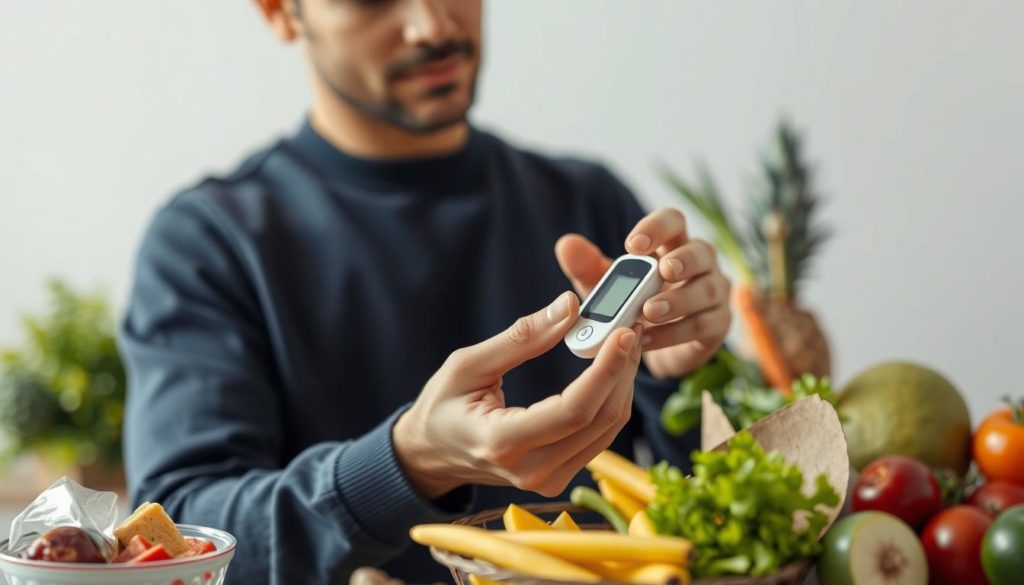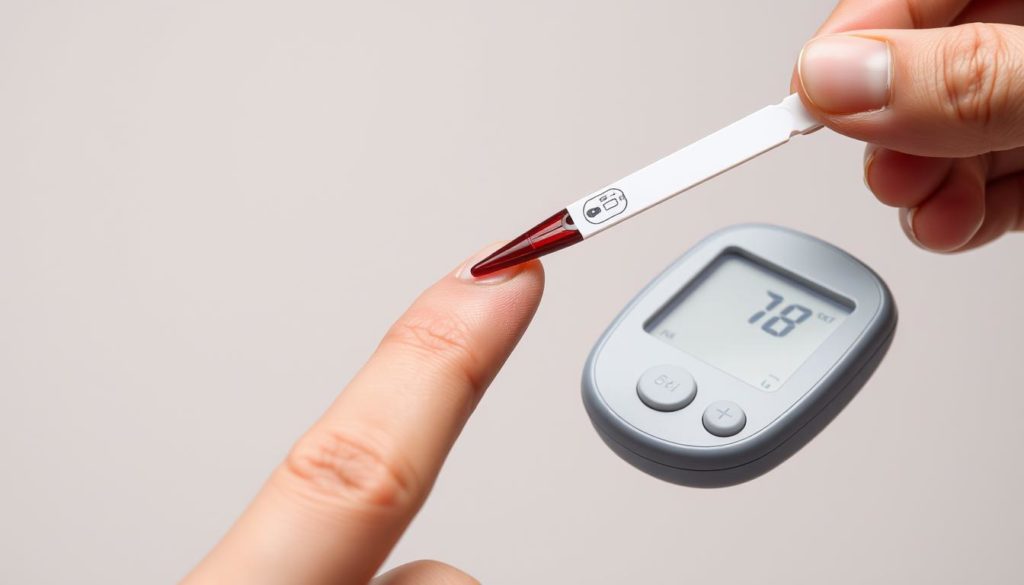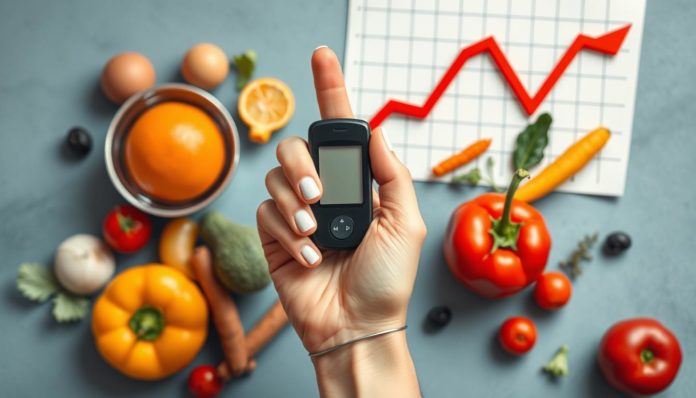Did you know nearly 1 in 10 Americans has diabetes, says the CDC? This shows how crucial it is to manage blood sugar levels well. In our detailed Blood Sugar Testing Guide, we dive into top advice for precise diabetes blood glucose monitoring.
Checking your blood sugar regularly is vital for your health. It helps you control diabetes and deal with any changes swiftly. Home devices give quick results, helping you and your doctor make smart choices about your lifestyle and blood sugar.
To keep your health on point, follow our guide. It covers everything from sticking to routines to keeping clean. Learn the best ways for managing diabetes with regular blood sugar checks here.
Importance of Blood Sugar Monitoring
Checking blood sugar levels is key in managing diabetes. It lets people keep control and avoid health issues later. Knowing why it’s important helps patients see how their daily habits affect their health.
Adding regular blood glucose checks into their care plan gives a clear picture of their health. This information is precious for doctors. It helps them give better advice and treatments. Highlighting the significance of checking blood sugar can really improve someone’s life. It lowers the chance of serious problems and makes dealing with diabetes easier.
Monitoring blood glucose levels is not just a task but a vital component that underpins a robust diabetes care plan. Consistent monitoring empowers individuals and informs their treatment regimen.

Also, tracking blood sugar readings can show trends that might be missed. Spotting these trends helps in adjusting diet and medication. This proactive approach is key in managing diabetes.
In the end, knowing why blood sugar monitoring matters and making it part of everyday life is the base for a healthy life, even with diabetes.
How to Test Blood Sugar at Home
Testing blood sugar at home is crucial for managing diabetes well. It starts with knowing how to get ready and use a blood glucose meter right for good results. We will cover the key steps and tips for testing blood sugar at home below.

Preparation Steps
To prepare for using a blood glucose meter, do the following steps:
- Handwashing: Wash your hands well with soap and warm water. Dry them fully to avoid moisture messing with the test strip.
- Gather Supplies: Make sure you have your blood glucose meter, test strips, lancet device, and alcohol wipes handy.
- Prepare Lancet: Put a new lancet in the device. Set the depth to what feels best for you.
Using a Blood Glucose Meter
Using a blood glucose meter right helps ensure your blood sugar tests are accurate. Here are the steps for best results:
- Insert the Test Strip: Insert a new test strip into the meter as the maker suggests.
- Obtain Blood Sample: Prick your finger’s side or another approved spot with the lancet device. Squeeze gently for a drop of blood.
- Apply Blood Sample: Touch the test strip’s edge to the blood drop. Your blood sugar level will show in seconds.
- Stop Bleeding: Stop any bleeding at the spot with an alcohol wipe or clean cotton.
- Dispose Safely: Throw the used lancet and test strip into a safe, puncture-resistant container.
Knowing the right way to test your blood sugar at home helps you get trustworthy data. This helps in managing your diabetes well. Key to this is using your blood glucose meter as it is supposed to be used for consistent, right blood sugar testing.
Best Blood Sugar Meters
Choosing the best blood sugar meters is key for good diabetes control. These devices give quick and reliable readings. They also have features like memory storage for past readings, important for monitoring blood sugar over time.
Think about how easy it is to carry the meter with you. Some of the best blood glucose monitors work with many test strips and have control solutions for exact testing. This helps make regular testing easier and more accurate.
It’s a smart move to ask healthcare experts about diabetes management tools. They can suggest the best meter for your needs, helping you choose wisely.
Here’s a comparison of some top-rated blood sugar meters:
| Model | Memory Storage | Portability | Test Strip Compatibility |
|---|---|---|---|
| Accu-Chek Guide | 720 readings | High | Accu-Chek Guide |
| Contour Next EZ | 800 readings | Medium | Contour Next |
| FreeStyle Lite | 450 readings | High | FreeStyle Lite |
Tips for Successful Blood Sugar Testing
Mastering blood sugar testing is key for good diabetes care. It’s important to keep things clean and record your blood sugar levels. This helps with accuracy and keeps you healthy.
Maintaining Good Hygiene
Keeping clean is essential for right blood sugar readings and avoiding infections. Always wash your hands with soap and warm water before you test. Make sure your testing supplies are clean too. Use new lancets and clean your meter with alcohol swabs. Following these tips for successful blood sugar testing makes your results more reliable and helps you stay healthy.
Logging Your Results
It’s critical to keep track of your blood glucose levels. By logging your results, you can see patterns and make the right changes to your care. You can use digital tools, journals, or apps for tracking. Always check your records against doctor’s tests to make sure your meter is right.
| Method | Pros | Cons |
|---|---|---|
| Digital Tools | Automated logs, Data analysis, Easy sharing with healthcare providers | Requires tech-savviness, Potential data security issues |
| Journals | Simple, No tech needed, Cost-effective | Manual entry, Easy to lose |
| Mobile Apps | User-friendly, Alerts and reminders, Syncs with devices | Requires smartphone |
Choosing the best method for you gives a full view of your logging blood glucose results. This leads to better health choices.
Preventing Sore Fingertips
Testing your blood sugar often can be hard on your fingertips. But, there are ways to make taking blood samples easier and more comfortable. Using different strategies can help a lot.
Alternate Fingers: Switching testing fingers keeps any from getting too sore. It gives each finger a break. Prick the Sides: It’s less painful to test on the sides of your fingertips. That area has fewer nerves. Use Warm Water: Warm water before testing can help blood flow better. This makes getting a sample easier with less pain. Don’t Reuse Lancets: Always use a new lancet for each test. Old ones can hurt more and cause infections.
If your finger gets sore, let it heal before testing again. Some glucose meters let you test on other body parts. This can lower your discomfort a lot. It’s important to find ways to test comfortably.
| Glucose Testing Comfort Tips | Benefits |
|---|---|
| Alternate Fingers Regularly | Distributes testing across multiple fingers to prevent soreness |
| Prick the Sides of Fingers | Reduces pain due to fewer nerve endings |
| Use Warm Water Prior | Increases blood flow, making it easier to collect blood samples |
| Use Fresh Lancets | Minimizes risk of infection and reduces pain |
Understanding Blood Sugar Levels
Knowing about blood sugar is key to manage diabetes well. Regular checks help you make smart health choices. This part will show how to read blood glucose levels and know ideal ranges for managing diabetes.
Interpreting Your Results
Reading your blood glucose results helps check if your treatment works. It shows if you need to change your medication, food, or exercise.
- High blood sugar (hyperglycemia) means your medicine or food might need changing.
- Low blood sugar (hypoglycemia) requires quick action, like eating fast-acting carbs.
For more on blood sugar levels and managing them, visit trustworthy medical sites.
Target Ranges
Target blood sugar levels change based on your age, health, and certain diabetes issues. The American Diabetes Association gives these general guidelines:
| Time of Day | Target Glucose Range (mg/dL) |
|---|---|
| Before Meals | 80-130 |
| 1-2 Hours After Meals | Less than 180 |
Remember, these ranges need adjusting by your healthcare provider. Keeping up with blood glucose checks and doctor visits helps keep your treatment right for you.
Managing Diabetes with Regular Blood Sugar Checks
Keeping an eye on your blood sugar is key when you have diabetes. It helps you stay healthy and avoid complications. Checking your glucose levels lets you and your doctor see how food, exercise, and meds affect you. It’s important to check regularly so you can make necessary changes fast.
Part of taking care of your diabetes is learning how to test your blood sugar the right way. A glucose meter can give you quick, accurate results. By checking often, your doctor can spot trends and adjust your treatment as needed.
Let’s look at how constant monitoring can really make a difference:
| Aspect | Regular Monitoring | Irregular Monitoring |
|---|---|---|
| Control Over Blood Sugar Levels | High | Low |
| Frequency of Doctor Visits | Less Frequent | More Frequent |
| Risk of Complications | Reduced | Increased |
Staying disciplined with your blood sugar checks is crucial for managing diabetes well. People who follow their care plans closely usually see better results. They also enjoy a better quality of life. Making regular glucose monitoring part of your daily routine is the best way to control your diabetes.
Blood Sugar Testing Guide
A comprehensive Blood Sugar Testing Guide is essential for anyone managing diabetes. Knowing how to test your blood sugar correctly is key. It helps you understand the results and adjust your diabetes care plan accordingly.
To get accurate blood sugar tests, some steps are important. First, prepare where you’ll test. Make sure your glucose meter works right. Then, choose the best time for testing. Following these steps leads to trustworthy results. This makes managing diabetes easier.
The Blood Sugar Testing Guide highlights when you should test your sugar. Testing before and after meals gives insights on how food impacts your sugar levels. This information is vital. It helps tweak your diabetes care plan for the better.
| Testing Time | Reason | Action |
|---|---|---|
| Fasting (Morning) | Establish baseline | Adjust insulin if necessary |
| Before Meals | Determine pre-meal levels | Plan meal targets |
| 2 hours After Meals | Monitor meal effect | Food and insulin adjustments |
| Before Bed | Ensure safe overnight levels | Adjust nighttime insulin |
It’s vital to use the right methods for testing blood sugar. It helps adjust to your dietary needs and activity levels. Staying consistent with a Blood Sugar Testing Guide keeps your glucose at the right levels. It also prevents complications.
Accurate Blood Sugar Testing Methods
Accurate blood sugar tests are key for good diabetes management. It’s important to use the right factors and approved sites for testing. While old glucose meters use finger samples, new ones can use less painful areas like forearms.
Alternative Testing Sites
Testing on alternative sites, like your forearm, can hurt less. This is great for those who test their blood sugar often. But, these sites may not be as accurate as fingertips, especially after eating or exercising. Always talk to a doctor before changing testing sites.
Factors Affecting Accuracy
Many things can change how accurate blood sugar readings are. These include the environment, the test strips, and the meter’s condition. Also, recent eating, hormone changes, and exercise can affect readings. Proper care and storage of your testing kit can help keep readings accurate.
FAQ
Why is blood sugar monitoring important?
Keeping an eye on blood glucose is key for managing diabetes well. It helps people change their food, exercise, and meds based on their sugar levels.
How can I test my blood sugar at home?
First, clean your hands and get your lancet and test strip ready. Put the strip into the meter, prick your finger for a drop of blood, and place it on the strip. Then wait for your result.
What are the best blood sugar meters available?
Top blood sugar meters give fast and accurate readings and are easy to use. Look for ones that have memory, are easy to carry, and work with many test strips. Talking to your doctor for advice is a good idea.
How do I maintain good hygiene during blood sugar testing?
Good hygiene means accurate blood sugar tests and no infections. Always wash hands well before testing. Keep your supplies clean and throw away used lancets and strips correctly.
How can I log my blood glucose results effectively?
Keeping track of your blood sugar is crucial. Use digital tools, paper journals, or apps to make it easier. Record your glucose numbers, what you eat, your meds, and how much you move.
How can I prevent sore fingertips from regular blood sugar testing?
To stop sore fingers, don’t use lancets more than once. Change which finger you use and prick the sides, not the tops. Warming your hands first helps get blood easier.
How do I interpret my blood sugar levels?
Understanding your blood sugar means comparing it to goals set by your doctor. Your numbers tell you if you need to change your food, activity, or medicine.
Why is consistency in blood sugar checks important for managing diabetes?
Checking your sugar levels regularly and at consistent times helps you see patterns. This info is key to adjusting your food, exercise, and meds better.
What should a comprehensive blood sugar testing guide include?
A complete guide should clearly explain how to test correctly. It should also teach you to understand your results and what to do if they’re off. Learning the right way and time to test is also covered.
What are accurate blood sugar testing methods?
To test your sugar right, use the correct sites for testing. Know what might change your results and keep your equipment in good condition. Always use new strips and check your meter.
What are alternative sites for blood glucose testing?
You can test your blood sugar on less sensitive parts like the forearm. This might hurt less if you test a lot.
What factors can affect the accuracy of blood sugar readings?
Old strips, wrong storage, broken meters, recent food, hormones, and exercise can mess with your readings. You need to calibrate often and test wisely.


